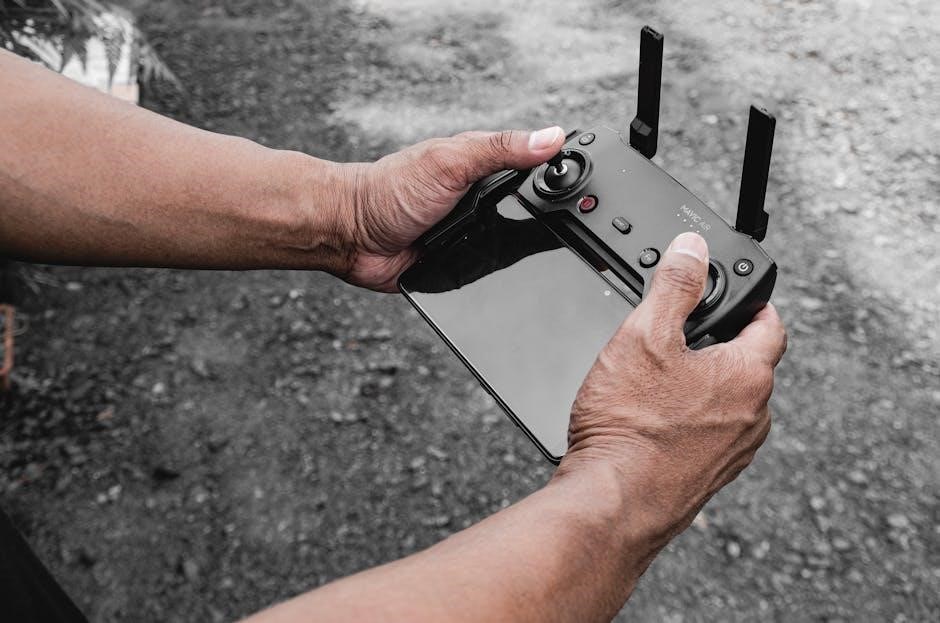
Welcome to the True LAE Controller Manual, your comprehensive guide to understanding and operating the BR1-28 controller. This manual covers installation, operation, and troubleshooting.
Overview of the True LAE Controller
The True LAE Controller, specifically the BR1-28 model, is a advanced temperature control system designed for precise refrigeration management. It features defrost modes, temperature monitoring, and safety alarms. The controller ensures efficient operation by managing compressors, fans, and defrost cycles. With a user-friendly interface, it allows for easy parameter configuration and monitoring. Safety features include high pressure and temperature alarms, ensuring reliable performance. This controller is essential for maintaining optimal conditions in refrigeration systems, making it a crucial component for commercial and industrial applications. Proper installation and setup are detailed in this manual.
Importance of the Manual for Optimal Use
This manual is essential for understanding the True LAE Controller’s features and functions. It provides step-by-step guidance for installation, configuration, and troubleshooting. By following the manual, users can ensure safe and efficient operation, prevent system damage, and maintain optimal performance. The manual also outlines safety precautions and best practices, making it a vital resource for technicians and operators. Regular reference to this guide will help maximize the controller’s lifespan and functionality, ensuring reliable refrigeration system control.

System Components and Installation
The True LAE Controller system includes key components like the BR1-28 controller, sensors, and wiring. Proper installation on a DIN rail ensures secure and reliable operation;
Key Components of the True LAE Controller
The True LAE Controller system consists of the BR1-28 controller, temperature sensors, and wiring harnesses. The BR1-28 is the central unit, managing temperature and defrost cycles. Sensors monitor temperatures, ensuring precise control. The control panel features buttons for navigation and adjustments. Wiring connects all components, enabling seamless communication. Additional accessories like relays and heaters are integrated for defrost operations. Each component is essential for optimal performance and reliability, ensuring efficient refrigeration system management.
Installation Steps for the BR1-28 Controller
First, securely attach the BR1-28 controller to a DIN rail, ensuring it is firmly mounted to prevent vibration. Follow the handling instructions carefully to avoid damage. Connect the wiring harnesses to the appropriate terminals, ensuring all connections are secure. Power on the controller and verify proper operation. Set passwords for system protection, as no default passwords are configured. Mount the unit in a well-ventilated area to maintain optimal performance and reliability. Refer to the manual for detailed wiring diagrams and safety precautions.
Mounting the Controller on a DIN Rail
To mount the BR1-28 controller on a DIN rail, ensure the rail is compatible with the controller’s dimensions. Align the controller’s DIN rail clips with the rail and securely fasten it using the provided screws. Tighten firmly to prevent loosening during operation. Verify that the controller is level and properly seated to ensure reliable performance. Refer to the manual for specific torque specifications and mounting hardware recommendations to guarantee a stable installation and optimal functionality.

Understanding the Control Panel
The control panel features an LCD display and navigation buttons. Up, Down, Info/Set Point, and Stand-By buttons enable easy monitoring and parameter adjustments.
Layout and Functionality of the Control Panel
The control panel is designed for intuitive operation, featuring an LCD display and a series of buttons for navigation and adjustments. The Up and Down buttons allow users to scroll through menus and adjust settings, while the Info/Set Point button enables viewing or modifying parameters. The Stand-By button toggles between active and standby modes. Additional buttons include Manual Defrost and navigation controls. The layout ensures easy access to critical functions, making it user-friendly for both monitoring and configuring the controller’s operations.
Explanation of Buttons and Their Functions
The control panel features several buttons with distinct roles. The Up and Down buttons adjust settings or navigate menus. The Info/Set Point button toggles between viewing information and setting parameters. The Manual Defrost button initiates or halts the defrost cycle. The Stand-By button switches between active and standby modes. These buttons provide precise control over the controller’s operations, ensuring easy management of temperature, defrost, and system status. Their functions are designed to streamline user interaction and maintain optimal performance.

Temperature Control Parameters
Key parameters include temperature setpoints, differential settings, and defrost controls. These ensure precise temperature regulation, preventing issues like frost buildup on the evaporator coil.
Setting the Desired Temperature Range
To set the desired temperature range, navigate to the parameter configuration menu. Use the Up or Down buttons to adjust the setpoint values. Ensure the range aligns with your application needs. Save changes by pressing the SET button. Proper configuration prevents issues like frost buildup and ensures efficient operation. Regularly monitor and adjust settings as needed to maintain optimal performance. Refer to the manual for detailed step-by-step instructions and safety guidelines.
Monitoring and Adjusting Temperature Settings
Monitor temperature settings via the control panel’s display, ensuring they align with your desired range. Use the Up and Down buttons to adjust setpoints as needed. The controller features real-time temperature display and alarm notifications for deviations. Regularly check the sight glass for proper refrigerant charge and inspect the condenser unit for efficiency. Adjustments should be made cautiously to avoid system imbalances. Refer to the manual for guidance on optimizing temperature control and maintaining stable operation. Proper monitoring ensures efficient performance and prevents potential issues. Regular checks are essential for long-term reliability.

Defrost Cycles and Configuration
The True LAE Controller manages defrost cycles to prevent frost buildup. During high pressure alarms, defrost is suspended for system protection. Configure defrost output for heater control, ensuring efficient operation and preventing ice accumulation on evaporator coils. This feature optimizes performance while maintaining temperature stability. Proper configuration is essential for reliable defrost operation and overall system efficiency. Refer to the manual for detailed setup instructions.
Understanding Defrost Modes and Types
The True LAE Controller offers multiple defrost modes to suit different applications. These include time-based and temperature-based defrost options, ensuring optimal performance. During defrost, the high temperature alarm is bypassed to prevent unnecessary alerts. The controller supports various defrost types, such as electric heater and hot gas defrost, which can be configured based on system requirements. Understanding these modes and types is crucial for maintaining efficiency and preventing issues like ice buildup. Proper setup ensures smooth operation and extends equipment lifespan.
Configuring Defrost Output and Heater Control
Configure defrost output to manage heater control effectively. The defrost output can drive a heater, ensuring efficient ice removal. Parameters like FT1, FT2, and FT3 regulate fan operation during defrost. During high pressure, defrost is suspended to prevent system damage. Ensure proper setup of defrost modes and heater control to maintain optimal performance. Refer to the manual for specific configuration steps and guidelines to customize settings based on your system requirements and environmental conditions for reliable operation and energy efficiency. Proper configuration ensures smooth defrost cycles and prevents overheating or icing issues. Always follow safety guidelines when adjusting these settings.

Safety Features and Alarms
The True LAE Controller includes high pressure and high temperature alarms to ensure system protection. Defrost is suspended during high pressure to prevent damage, while high temperature alarms are bypassed during defrost cycles to maintain safe operation and efficiency.
High Pressure and High Temperature Alarms
The True LAE Controller incorporates high pressure and high temperature alarms to ensure system safety. These alarms activate when pressure or temperature levels exceed predefined thresholds, halting operations to prevent damage. During high pressure conditions, defrost functions are suspended to maintain system integrity. High temperature alarms are temporarily bypassed during defrost cycles to allow necessary temperature adjustments without triggering false alarms, ensuring efficient and safe operation. These features protect the controller and connected equipment from potential damage, promoting reliable performance and longevity.
Defrost Suspension During High Pressure
The True LAE Controller features defrost suspension during high pressure events to protect the system. When high pressure is detected, the defrost cycle is automatically halted to prevent potential damage. This ensures safe operation by prioritizing system integrity. During defrost, high temperature alarms are temporarily bypassed to avoid false triggers. Once pressure returns to normal, defrost resumes automatically, balancing safety and efficiency. This feature ensures reliable performance while safeguarding the controller and connected equipment from excessive stress.

Troubleshooting Common Issues
Troubleshooting the True LAE Controller involves identifying issues like compressor malfunctions or refrigerant line blockages. Check fans and defrost settings for optimal performance and system longevity.
Identifying and Resolving Compressor Issues
Identifying compressor issues involves checking for unusual noises, vibrations, or failure to start. Ensure the temperature control is set correctly and verify refrigerant levels. If the compressor doesn’t activate, inspect wiring and relays. Clean condenser coils and check for blockages in refrigeration lines. Refer to the True LAE Controller Manual for specific troubleshooting steps and guidelines to restore functionality and prevent further damage. Regular maintenance can help avoid compressor-related problems. Always follow safety protocols when handling electrical components.
Checking Refrigeration Lines and Fans
Regularly inspect refrigeration lines for blockages or damage to ensure proper airflow. Remove the front grille and verify that lines are free from obstructions. Check the condenser fan for smooth operation; spin the blade manually to ensure it rotates freely. Clean the evaporator coil to prevent frost buildup. Ensure fans activate correctly when the compressor cycles on or off. Refer to the True LAE Controller Manual for detailed inspection and maintenance procedures to maintain optimal system performance and efficiency. Proper care extends equipment lifespan and prevents operational issues.

Maintenance and Care
Regular maintenance ensures optimal performance and longevity. Clean the controller and inspect connections monthly. Replace worn parts promptly and follow manual guidelines for routine care tasks.
Routine Maintenance Tasks for Optimal Performance
Regularly inspect and clean the controller to prevent dust buildup. Check all connections and wiring for signs of wear or damage. Ensure the condenser coils are free from debris for efficient operation. Replace any faulty components promptly to maintain performance. Schedule periodic software updates to access new features and improvements. Refer to the manual for detailed guidelines on maintenance schedules and procedures to ensure the controller operates efficiently and reliably over time. Always follow safety precautions during maintenance to avoid damage or injury.
Cleaning and Inspecting the Controller
Regular cleaning and inspection are crucial for maintaining the controller’s performance. Use a soft, dry cloth to wipe down the exterior and internal components. Remove the front grille to inspect refrigeration lines, ensuring they are free from obstructions. Check the evaporator coil and fan blades for dust or debris, cleaning them as needed. Inspect wiring and connections for wear or damage. Refer to the manual for specific cleaning procedures to ensure all components function correctly and prolong the controller’s lifespan. Always disconnect power before performing maintenance tasks.

Accessing Parameter Configuration
Access the parameter configuration menu by pressing the designated button for 5 seconds. Use navigation buttons to select and modify parameters as needed for optimal controller performance.
Entering the Parameter Configuration Menu
To enter the parameter configuration menu, press the designated button for 5 seconds. The display will show “Menu” or “Parameters.” Use the navigation buttons to scroll through available settings. Select the desired parameter using the “Set” or “Enter” button. Adjust the value using the up or down arrows. Press “Save” to confirm changes. Ensure all modifications align with the controller’s operational requirements for optimal performance and reliability. Refer to the manual for specific button functions and parameter details. Proper configuration is essential for maintaining efficient system operation.
Navigating and Modifying Parameters
Navigate through the parameter menu using the up and down arrows to scroll through options. Select a parameter by pressing the “Set” or “Enter” button. Use the arrow keys to adjust the value. Press “Save” to confirm changes. Parameters control functions like temperature thresholds, defrost timing, and fan operation. Ensure modifications align with system requirements. Review changes carefully before saving. Restart the controller if necessary for updates to take effect. Always refer to the manual for default settings and operational guidelines to maintain optimal performance and safety. Proper navigation ensures precise control of the system’s behavior.

UPS and Power Management
The UPS is shipped off and must be powered on during initial setup. Follow instructions to configure settings for reliable power management and system protection.
Powering On the UPS for the First Time
Powering on the UPS for the first time involves locating the power button, typically on the front or top of the unit, and pressing it until the UPS activates. Once powered on, configure the settings according to the manual’s instructions to ensure optimal performance. This includes setting the correct voltage and ensuring the system recognizes the UPS. After configuration, test the UPS by disconnecting the main power to verify it kicks in and maintains the controller’s operation. If issues arise, refer to the manual for troubleshooting steps.
Configuring UPS Settings for Reliable Operation
Navigate to the UPS settings menu via the control panel to configure the backup duration, sensitivity, and output voltage. Set the backup time according to your needs and ensure the UPS is correctly calibrated for your power requirements. Enable auto-restart if desired for seamless operation after power restoration. Save all changes to ensure settings persist. Regularly test the UPS in battery mode to confirm proper function. Refer to the manual for specific configuration instructions tailored to your system.
This manual provides essential guidance for the True LAE Controller, ensuring optimal performance and safety. Refer to it regularly for troubleshooting, maintenance, and configuration support.
This manual serves as a comprehensive guide for the True LAE Controller, detailing its components, installation, and operation. It covers temperature control, defrost cycles, safety features, and troubleshooting. Proper installation on a DIN rail and configuration of parameters ensure optimal performance. Regular maintenance, such as cleaning and inspecting the controller, is essential for longevity. Understanding alarms and troubleshooting common issues helps maintain efficiency. By following the guidelines, users can ensure safe and reliable operation of the True LAE Controller in various applications.
Final Tips for Effective Use of the True LAE Controller
To maximize the performance of the True LAE Controller, ensure proper installation on a DIN rail and configure parameters according to your needs. Regularly clean and inspect the controller to prevent malfunctions. Always monitor temperature settings and defrost cycles to maintain efficiency. Familiarize yourself with alarm systems to address issues promptly. Refer to this manual for troubleshooting guidance and follow maintenance schedules for optimal operation. By adhering to these tips, you can ensure reliable and safe operation of the True LAE Controller.